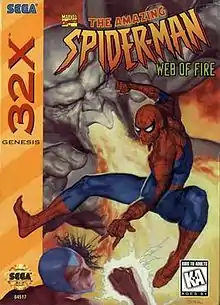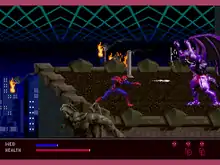The Amazing Spider-Man: Web of Fire
The Amazing Spider-Man: Web of Fire[lower-alpha 1] is a side-scrolling action-adventure video game developed by BlueSky Software and published by Sega exclusively for the 32X add-on in North America on March 1996. Based on the popular Marvel Comics superhero Spider-Man, it is inspired by the long-running comic book mythology and adaptations in other media. In the main storyline, the terrorist organization H.Y.D.R.A. and the New Enforcers orchestrate a plot to shroud New York City under an electrical plasma grid, trapping its citizens. Spider-Man must confront each of the New Enforcers members, foil Hydra's plans, and save the city with the aid of Daredevil.
| The Amazing Spider-Man: Web of Fire | |
|---|---|
 | |
| Developer(s) | BlueSky Software |
| Publisher(s) | Sega |
| Producer(s) | Jerry Huber Jerry Markota |
| Designer(s) | Zono |
| Programmer(s) | Brian Belfield Keith Freiheit |
| Artist(s) | Chris Kreidel Drew Krevi John Whitson |
| Writer(s) | Curtis Clarkson |
| Composer(s) | Brian L. Schmidt Sam Powell |
| Series | Spider-Man |
| Platform(s) | 32X |
| Release |
|
| Genre(s) | Action-adventure |
| Mode(s) | Single-player |
Headed by co-producers Jerry Huber and Jerry Markota, Spider-Man: Web of Fire was created by most of the same team that previously worked on several projects at BlueSky Software such as Vectorman and its sequel. It was the last game released for the 32X platform in North America after Sega discontinued support for the add-on, who produced a limited run of copies in total as a result.
Spider-Man: Web of Fire received mixed reception from the few video game magazines and gaming-dedicated outlets that covered the game, with critics divided in regards to aspects such as presentation, visuals, audio, controls and gameplay. The title served as the final Marvel Comics-licensed release by Sega until 2008's Iron Man.
Gameplay

The Amazing Spider-Man: Web of Fire is a side-scrolling action-adventure game where the players control Spider-Man through six stages as he goes up against the terrorist organization H.Y.D.R.A., who has taken all of New York City and its citizens as hostage by setting up generators that caused a giant electrical grid to appear over the location, and their hired hands the New Enforcers.[1] The New Enforcers are each guarding the generators to make sure Hydra's plans go uninterrupted. At the end of the stages, Spider-Man must confront each member of the New Enforcers while destroying each generator in order to progress further. The bosses are Dragon Man, Eel, Thermite, Blitz and Super-Adaptoid. Vanisher also appears although he is not a boss. On the main menu, the player has access to the options menu where various settings can be changed such as controls and difficulty level.[1]
Spider-Man can jump, punch, kick, duck, crawl, climb certain walls, shoot webs to swing on and collect web fluid to shoot web projectiles against enemies, among other actions.[1] Spider-Man can also get assistance from fellow superhero Daredevil by rescuing him in the first stage and collecting "DD" tokens scattered through the stages.[1] Other items can also be picked up such as health packs to restore energy.[1] Spider-Man has three lives at the beginning of the game and extra lives can be acquired along the way but once all lives are lost, the game is over, though the player has the choice to continue playing after dying.[1]
Synopsis
The plot of The Amazing Spider-Man: Web of Fire is explained through newspaper-styled cutscenes. H.Y.D.R.A. and the New Enforcers orchestrate a plan to cover New York City under an electrical plasma grid, trapping its citizens and unleashing chaos as a result. The New Enforcers are guarding the grid's generators to ensure Hydra's schemes go uninterrupted. Spider-Man must face against each of the New Enforcers, foil Hydra's plans, and rescue the city with help from Daredevil.[1]
Development and release

The Amazing Spider-Man: Web of Fire was created by most of the same team that worked on previous projects at BlueSky Software such as Vectorman and its sequel.[1] Its development was helmed by co-producers Jerry Huber and Jerry Markota, with Brian Belfield and Keith Freiheit acting as lead programmers.[1] California-based developer Zono assisted with game design, while several artists were responsible for the pixel art.[1] The character graphics were rendered on Silicon Graphics workstations, using motion captured animation.[2] The soundtrack was co-created by composers Brian L. Schmidt and Sam Powell.[1]
Spider-Man: Web of Fire was released exclusively in North America by Sega in March 1996,[2][3] after they had announced that they were dropping support for the system.[4][5] It was the last game released for the 32X in the region, with an estimated production run of 1,500 copies.[6][7] It has since become one of the more expensive titles on the platform due to its limited run, with cartridges fetching over US$200-400 on the secondary video game collecting market.[5][7][8] Prior to release, it was showcased at events like E3 1995.[9]
Reception and legacy
| Publication | Score |
|---|---|
| GamePro | 15 / 20[10] |
| Game Players | 36%[11] |
| Manci Games | B+[12] |
The Amazing Spider-Man: Web of Fire was largely ignored by the gaming press, perhaps in part because it was released after Sega had already announced they were dropping support for the 32X;[4] GamePro and Game Players gave it only brief reviews, while other gaming publications such as Electronic Gaming Monthly, GameSpot and Next Generation gave it no coverage at all beyond early previews.[3] GamePro said the game was a "decent side-scrollin', web-slingin', thug-punchin' fun, featuring nimble sprites, lots of crawly moves, and fine graphical details. Spider-Man: Web of Fire won't disappoint Marvel fans, though it doesn't raise Spidey to the pantheon of great video game heroes".[10] Roger Burchill of Game Players lambasted the game's lack of innovation, unimpressive and dated graphics, dull and formless music and repetitive sound design.[11]
Spider-Man: Web of Fire served as the final Marvel Comics-licensed title published by Sega until Iron Man in 2008 for sixth and seventh generation consoles, due to internal issues between Sega and Marvel.[13]
Notes
- The title appears as Spider-Man: Web of Fire on the title screen.
References
- The Amazing Spider-Man: Web of Fire instruction manual (Sega 32X, US)
- "Short ProShots - Spiderman: Web of Fire". GamePro. No. 88. IDG. January 1996. p. 55.
- "First Look: Genesis 32X - Spider-man: Web of Fire". VideoGames - The Ultimate Gaming Magazine. No. 84. L.F.P., Inc. January 1996. p. 58.
- "ProNews: Inside Scoop - Sega Shuffles Staff and Systems". GamePro. No. 91. IDG. April 1996. p. 16.
- Reichert, Nick; Gracin III, G (4 January 2018). "The Rarest and Most Valuable Sega 32X Games". Racketboy. Archived from the original on 6 March 2018. Retrieved 5 January 2020.
- Pettus, Sam; Munoz, David; Williams, Kevin; Barroso, Ivan; Chen, David (18 December 2013). Anatomy of a Failure: The Sega 32X - A run for the roses. Service Games: The Rise and Fall of SEGA: Enhanced Edition (1st ed.). Smashwords Edition. pp. 159–167. ISBN 9781311080820. Retrieved 29 January 2014.
- Rignall, Jaz (27 December 2015). "System Swan Songs: The Last Games Released on the Greatest Consoles". USgamer. Gamer Network. Retrieved 5 January 2020.
- "The 25 best Spider-Man games of all time - In which game did the wallcrawler best climb walls?". GamesRadar+. Future Publishing. 6 July 2017. Retrieved 5 January 2020.
- García, Marcos; Martín, Fernando (June 1995). "Reportaje - Electronic Entertainment Expo: Una Feria Elevada Al Cubo - Sega". Superjuegos (in Spanish). No. 38. Grupo Zeta. p. 18.
- Nihei, Wes (April 1996). "Quick Hits - ProReview: Spider-Man: Web of Fire". GamePro. No. 91. IDG. p. 89.
- Burchill, Roger (March 1996). "32X - Review - Spider-man: Web of Fire". Game Players. No. 82. Signal Research. p. 65.
- Belmont, Michael (June 2002). "RetroReview - Spiderman: Web of Fire". Manci Games. No. 2. Manci Games, Inc. p. 37.
- Horowitz, Ken (19 October 2016). Alpha (Amoeba) Group. Playing at the Next Level: A History of American Sega Games. McFarland & Company. p. 192. ISBN 9780786499946. Retrieved 5 January 2020.

